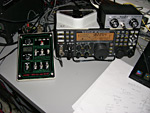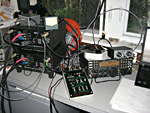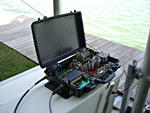
 |
news | location | equipment | LOG search | QSL info | photos | support |  |
EQUIPMENT
We try to tread the thin line between minimizing the equipment we carry and being effective, especially being able to put out a good TX signal on 160 meters. This is for two reasons: a) we do not like large, cumbersome operations, and b) our transport, the motor vessel Pedro (previously known as the Varzin), is a 17 meter motor-boat that was originally built as a high speed search and rescue boat and was not intended for long range open-ocean crossings, which the 900 km passage from the Australian coast to Mellish Reef certainly is. As the boat does not have the range required, we will be carrying additional diesel fuel in bladder tanks, which will take up whatever little storage space there is. Therefore we will have a tight limit on the equipment and generator fuel we can take. (And other stuff, like food and comfort items.)Antennas: In the past we had good results with vertical and inverted L antennas standing in the sea. Not close to the sea, not next to it, but in it! Erecting verticals in the sea, however, is challenging. You have to work in the water, which can be physically difficult. Also, everything must be water-tight and corrosion resistant. Wave action can be significant, thus the supports and connections must be both physically and electrically strong. Most importantly, the rise and fall of tides can substantially change the antenna's feed-point impedance. (Tides on Mellish Reef are up to 1.8 meters.) These impedance changes more or less preclude the use of pre-cut antennas with "coax friendly" feed-point impedances, especially for the low bands where they can not be elevated sufficiently to avoid the effects of tides.
For Mellish we must do with a single TX antenna. The planned TX antenna is a new design that uses two 18 meter spider poles. It employs three vertical wires and one horizontal wire in an inverted U format. We expect this design to work well from 160 to 10 meters with good low angle characteristics on all bands.
The heart of our unique "water-based" antenna system is the home brew, water-tight 1 kW antenna coupler. The coupler allows us to use a single antenna structure for all bands and it automatically compensates for the changes caused by the rising and falling tides. This, and an appropriate set of supports, is key to being able to erect the antennas in the water.




The description of the antenna system is now available as a downloadable PDF document at
http://vk9gmw.com/documents/VK9GMW_ANTENNA.pdf.
Radios:
K3 and ICOM IC-746 PRO
Amplifiers:
Two SGC SG-500 solid state amplifiers.
Power:
A single 240 V, 1.5 kW Honda generator, four 12 Volt car batteries, and three low cost battery chargers. All equipment will operate from 12 V DC.

